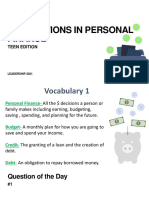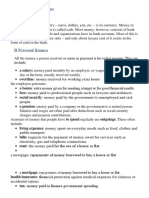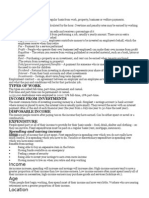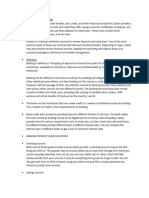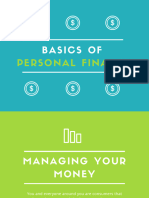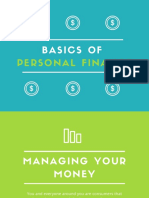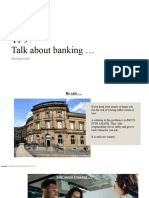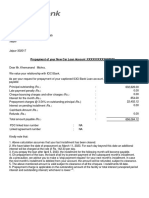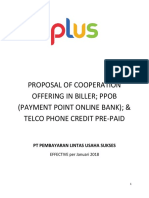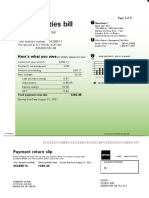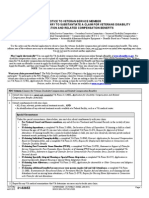Basic Financial Literacy Guide
4 Buitensingel St, Schotsche Kloof
Cape Town, South Africa
8001
www.nicro.org.za
Page 1 of 12
�Introduction
This document has been developed by NICRO at the request of our beneficiaries. It is
being made available to the general public as part of our crime and violence prevention
service. Individuals and organisations may make use of this document for non-profit and
educational purposes.
WHAT ARE BANKS
A bank is a business that offers banking products and
services that you pay for
WHAT DO BANKS DO
Banks offer a range of banking services and products to people and other businesses,
such as companies. Banks charge for their services and products.
HOW DO BANKS MAKE A PROFIT
A bank is a business. It must make money to survive. Banks make money by charging
people and companies to use their services. These charges include:
Banking fees
Transaction fees
Debit order fees
Account fees
Interest
It costs the bank to operate as a business. Bank business costs include:
Electricity,
Staff
Office rental Insurance Equipment water and
salaries
internet
Banks need to earn enough money to cover these costs, AND make a profit.
Page 2 of 12
�SHAREHOLDERS
Banks are a business. They must not only make enough money
to cover their costs, they must also make a profit, which is then
shared amongst the bank shareholders. Bank shareholders
are people have invested their private money by buying shares
in the bank in order to make more money with their
investment. Anyone can buy shares in a bank. Buying a share
in a bank means you own a small piece of the bank’s profit.
WHY IS THIS IMPORTANT TO KNOW?
This is important to know, because many people think a
bank’s business is to lend people money. This is not true. A
bank’s business is to earn money by charging for banking
products. This money covers the bank’s costs and what is left
is shared amongst the bank’s shareholders.
BANKING PRODUCTS
Below is a list of the most common banking products.
Banking Product What it is For Charges
TRANSACTION An account used to hold • Bank pays you interest
ACCOUNT (ALSO money for payments • You pay transaction and
CALLED A CHEQUE admin costs
ACCOUNT)
SAVINGS ACCOUNTS An account used to save • Bank pays you interest
money • You pay transaction and
admin costs
CREDIT CARDS A card with a set amount of • You pay the bank
credit loaded on it that can interest
be used for payments. • You pay transaction and
admin costs
HOME LOANS A loan for a set amount • You pay the bank
used to buy a house interest
VEHICLE FINANCING A loan for a set amount • You pay the bank
used to buy a car interest
Page 3 of 12
� Banking Product What it is For Charges
DEBIT ORDERS A set recurring payment • You pay transaction and
from your account admin costs
DEBIT CARDS A card linked to either a • You pay transaction and
transaction or savings admin costs
account, used to make
payments or withdraw cash
at an ATM
INTEREST
The term ` interest` is a fee that has to be paid, by either you or the bank.
You pay interest on money you owe the bank. The bank pays you interest on
your savings in the bank. The amount of interest that has to be paid is worked
out as a percentage of a larger amount, such as savings or a loan.
For example:
• If you spend R100 on a credit card, and do not pay it back within the required time,
you will have to pay the R100 plus 20% of R100 as interest, which will be R20.
• You will have to pay R100 plus R20 = R120.
Interest is also paid on bank savings. The bank will pay you a percentage of your savings
over a fixed period. For example:
You have R100 in your savings account
Your bank has a savings interest rate of 5%
Your bank will pay you 5% of the R100, which is R5
You will then have R105
Different banks have different interest rates and payment periods for credit and savings.
It makes sense to compare the interest and payment periods of different banks when
choose where to bank.
Page 4 of 12
�Budgets
A budget is a plan of how you will spend your money over a period of
time. A budget is very useful because:
It allows you to plan ahead on how you will spend your
money
It improves the control you have over your money
It helps you see where money can be saved and
expenses cut back
WHAT IS THE DIFFERENCE BETWEEN A PERSONAL BUDGET AND A BUSINESS
BUDGET?
A personal budget is a spending plan for your personal life, and
covers things like your daily home and personal expenses.
A business budget is a spending plan for a business, and covers
things like business expenses.
WHAT INFORMATION GOES INTO A BUDGET
ITEMS PERSONAL BUDGET BUSINESS BUDGET
MONEY EARNED Salary / wages Sales of products and
services
SASSA grants Business loans
Business grants
MONEY SPENT Rent Staff salaries
Food and toiletries Rent
Electricity and water Electricity and water
Airtime and data Airtime and data
School fees Advertising
Transport Transport and petrol
Medical care Equipment
Insurance / stockvel / Repairs and maintenance
funeral plans
Credit / store cards Security
Clothing Insurance
Page 5 of 12
�BASIC PERSONAL BUDGET TEMPLATE
INCOME
1. Salary / wages R
2. Grants R
3. __________________________________ R
4. __________________________________ R
5. __________________________________ R
Total Income R
EXPENSES
1. Rent R
2. Water R
3. Electricity R
4. Data R
5. Airtime R
6. School fees R
7. Childcare R
8. Food R
9. Toiletries R
10. Transport R
11. Savings / stokvel R
12. Credit debt R
13. Clothing R
14. Medical care R
15. __________________________________ R
16. __________________________________ R
17. __________________________________ R
18. __________________________________ R
Total Expenses R
TOTAL INCOME MINUS TOTAL EXPENSES R
Page 6 of 12
�BASIC BUSINESS BUDGET TEMPLATE
INCOME
1. Sales R
2. Business loans R
3. Business grants R
4. __________________________________ R
Total Income R
EXPENSES
1. Rent R
2. Water R
3. Electricity R
4. Telephone R
5. Internet R
6. Insurance R
7. Raw materials / stock R
8. Staff salaries R
9. Transport and petrol R
10. Car vehicle loan / hire R
11. Accounting services R
12. Taxes R
13. Advertising and marketing R
14. Repairs and maintenance R
15. Bank charges R
16. Printing R
17. License and registration fees R
18. Credit debt R
19. __________________________________ R
20. __________________________________ R
Total Expenses R
TOTAL INCOME MINUS TOTAL EXPENSES R
Page 7 of 12
�Savings and Cheque Accounts
WHAT IS A SAVINGS ACCOUNT?
A savings account is a bank account that you use to keep your
money in. The bank will pay you slightly more interest on money in
your savings account. However, banks tend to charge more for
payments made out of your savings account.
WHAT IS A CHEQUE ACCOUNT?
A cheque account is a bank account that you use for daily and monthly payments. Most
people have their salary paid directly into their cheque account. Banks pay very little or
no interest on money in your cheque account. However, many banks charge little or no
fees for payments made out of your cheque account. Most cheque accounts come with
packages of free ATM withdrawals, debt orders and point of sale (teller) payments per
month.
Account Type Bank Transaction Used Mainly For Interest Paid by
Charges Bank to You
Savings account Higher than for Savings Higher than for
cheque accounts cheque accounts
Cheque account Lower than for Daily and monthly Lower than for
savings accounts payments savings accounts
Based on the above, it may be better to:
• Have a savings account where you keep your savings because the bank pays higher
interest on savings accounts.
• Have a cheque account from which you make your payments because the bank has
lower transactions fees for payments on cheque accounts.
Take note that different banks offer different packages and rates for cheque and savings
accounts.
Page 8 of 12
�WHAT ARE THE BENEFITS OF HAVING A SAVINGS OR CHEQUE ACCOUNT?
The main benefits of using bank accounts rather than keeping cash are as follows:
Your money less You can earn
You can make
It is safer likely to be interest on
payments easily
stolen savings accounts
The costs of having a savings or cheque account are as follows:
The fee paid to open the account
The monthly admin fee to maintain the account
Transaction fees for using the account
Savings and
cheque Saving accounts earn more
accounts pay
different
interest
interest
rates
Cheque accounts earn less
interest
Savings and
cheque Cheque accounts charge less
accounts
charge
different
amounts for
transactions Savings accounts charge more
and
payments
Page 9 of 12
�Credit
The term `credit` means money that has been lent to someone to buy goods or services.
We get credit on bank credit cards. Store cards like
Woolies and PEP store cards are also credit cards,
but they can only be used to buy things at that shop.
We have to pay credit back.
The lender has a payment period during which we
can pay our credit back. If we do not pay back the credit within that payment period, we
get charged interest. You have already learnt about interest in a previous topic. Interest
is calculated as a percentage of the amount owning. Different lenders charge different
interest rates. You then have to pay back the full amount, plus interest.
WHAT IS THE DIFFERENCE BETWEEN GOOD AND BAD CREDIT
There is a difference between good credit and bad credit.
Bad credit is when we use
Good credit is credit that we credit to buy things that do
use to: not increase our overall
worth or value, such as:
• Increase our overall worth • Clothing
or value • Food
• Paying for an education, • Decorations and household
which will increase our items
chances of earning more • Vehicles – vehicle lose their
money worth over time. You will
• Starting a small business never sell your car for the
• Buying property that will same price as you bought it
increase in value over • Entertainment
time
Page 10 of 12
�WHEN SHOULD YOU USE CREDIT
You should limit yourself to using credit for the following reasons:
To improve your overall worth or value, such as
investing in education or starting a small business
To buy property that will increase in value overtime
To pay for emergencies such as medical care
If you use credit for products that do not increase your worth or value, then you are:
Wasting money End up paying more that the actual
cost of the item when you pay the
amount back in monthly payments
The rules of credit are:
Never use credit if an item does Instead of buying items on
not add to your overall wealth credit, rather save the money
or value and: each month and buy in cash
a.Is not a medical emergency
b.You cannot afford to buy it in cash
Page 11 of 12
�THE BAD CREDIT TRAP
Many people fall into a credit trap because:
Because they are not
They buy lots of things
paying the full amount They don’t realise how
that do not increase
upfront, they feel like much they end up
their overall worth or
they are not spending paying back in the end
value
money
AVOID FALLING INTO A CREDIT TRAP.
If you are in a credit trap, cut back your other expenses as much as you can pay the debt
off as quickly as possible, so you pay less in interest.
Lindiwe
• Lindiwe buys nice towels at Ackermans in her store
credit card for R300
• She pays this money back in small instalments over
the next six months
• She ends up paying Ackermans R300 for the towels
plus:
o A monthly service fee on Ackerman’s store card
o Interest on the R300
• By the time she has paid off her towels, she has
actually spent R520 on the towels
Lebogang
Lebogang wants to buy nice towels at Ackermans
that cost R300
She saves money each month until she has the R300
She buys the towels for R300
WHO MADE THE BETTER CHOICE AND WHY?
Page 12 of 12













